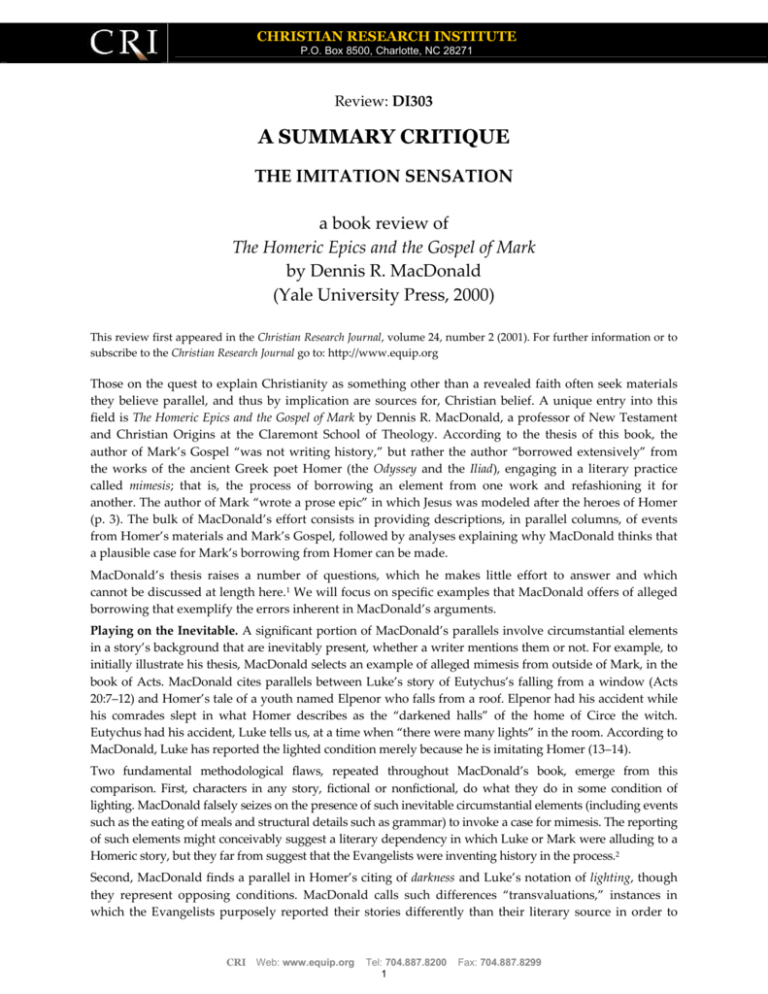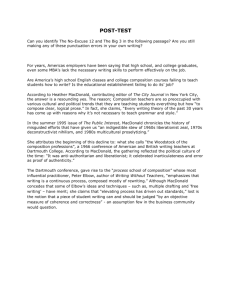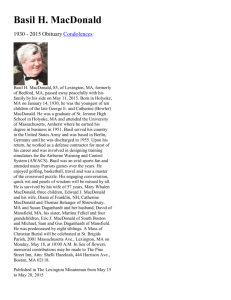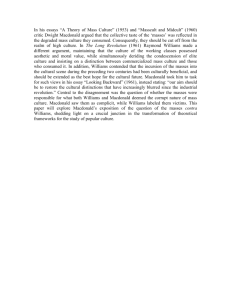A SUMMARY CRITIQUE
advertisement

CHRISTIAN RESEARCH INSTITUTE P.O. Box 8500, Charlotte, NC 28271 Review: DI303 A SUMMARY CRITIQUE THE IMITATION SENSATION a book review of The Homeric Epics and the Gospel of Mark by Dennis R. MacDonald (Yale University Press, 2000) This review first appeared in the Christian Research Journal, volume 24, number 2 (2001). For further information or to subscribe to the Christian Research Journal go to: http://www.equip.org Those on the quest to explain Christianity as something other than a revealed faith often seek materials they believe parallel, and thus by implication are sources for, Christian belief. A unique entry into this field is The Homeric Epics and the Gospel of Mark by Dennis R. MacDonald, a professor of New Testament and Christian Origins at the Claremont School of Theology. According to the thesis of this book, the author of Mark’s Gospel “was not writing history,” but rather the author “borrowed extensively” from the works of the ancient Greek poet Homer (the Odyssey and the Iliad), engaging in a literary practice called mimesis; that is, the process of borrowing an element from one work and refashioning it for another. The author of Mark “wrote a prose epic” in which Jesus was modeled after the heroes of Homer (p. 3). The bulk of MacDonald’s effort consists in providing descriptions, in parallel columns, of events from Homer’s materials and Mark’s Gospel, followed by analyses explaining why MacDonald thinks that a plausible case for Mark’s borrowing from Homer can be made. MacDonald’s thesis raises a number of questions, which he makes little effort to answer and which cannot be discussed at length here.1 We will focus on specific examples that MacDonald offers of alleged borrowing that exemplify the errors inherent in MacDonald’s arguments. Playing on the Inevitable. A significant portion of MacDonald’s parallels involve circumstantial elements in a story’s background that are inevitably present, whether a writer mentions them or not. For example, to initially illustrate his thesis, MacDonald selects an example of alleged mimesis from outside of Mark, in the book of Acts. MacDonald cites parallels between Luke’s story of Eutychus’s falling from a window (Acts 20:7–12) and Homer’s tale of a youth named Elpenor who falls from a roof. Elpenor had his accident while his comrades slept in what Homer describes as the “darkened halls” of the home of Circe the witch. Eutychus had his accident, Luke tells us, at a time when “there were many lights” in the room. According to MacDonald, Luke has reported the lighted condition merely because he is imitating Homer (13–14). Two fundamental methodological flaws, repeated throughout MacDonald’s book, emerge from this comparison. First, characters in any story, fictional or nonfictional, do what they do in some condition of lighting. MacDonald falsely seizes on the presence of such inevitable circumstantial elements (including events such as the eating of meals and structural details such as grammar) to invoke a case for mimesis. The reporting of such elements might conceivably suggest a literary dependency in which Luke or Mark were alluding to a Homeric story, but they far from suggest that the Evangelists were inventing history in the process.2 Second, MacDonald finds a parallel in Homer’s citing of darkness and Luke’s notation of lighting, though they represent opposing conditions. MacDonald calls such differences “transvaluations,” instances in which the Evangelists purposely reported their stories differently than their literary source in order to CRI Web: www.equip.org Tel: 704.887.8200 1 Fax: 704.887.8299 conceal their practice of imitation. If MacDonald allows for citation of either “likes” or “opposites,” or of any condition related to what is found in the “original,” then regardless of what condition of light Luke cited, MacDonald will argue that there is a parallel, and therefore, evidence of fabrication. One could hardly say, since some condition of light is inevitable, that the mere citation of this or other inevitable conditions is evidence for fictionalizing. If MacDonald’s logic is taken to its unavoidable conclusion, it would have been impossible for ancient writers to report an incident of someone’s falling from a height without being charged with writing fiction, unless they ensured that they reported none of the same elements found in Homer’s epics. MacDonald counts even “transvaluations” as evidence of imitation, and therefore his theory of imitation by the Evangelists becomes, to the extent that he accepts such evidence, unfalsifiable. He never explains how his theory would differentiate between literary imitation and wholesale historical fabrication — he merely assumes that the first proves the second.3 Finally, MacDonald marks his cards further by moving too freely between Homeric characters and events to find parallels. In matching Mark’s story of the healing of the demoniac with a story of Odysseus confronting Circe the witch, MacDonald first compares the behavior of the demoniac with Circe, but later makes Odysseus the demoniac’s parallel. Later yet, he makes the demoniac a parallel to the character of the one-eyed Cyclops, and finally, Odysseus is again matched with the demoniac, and the Cyclops is instead paralleled to Jesus (64–69). With such free use of the text, combined with the other loose criteria MacDonald has allowed for himself (i.e., counting transvaluations as matches), it is no surprise that MacDonald can find so many parallels. Stretching the Truth. MacDonald also stacks the deck in his favor by committing a type of literary equivocation. Parallels are unconvincing when read directly from the Homeric and biblical texts, but MacDonald achieves them by providing his own descriptions of events that he designs to sound as similar as possible. In the process he must ignore or downplay vast differences in the stories that would argue against imitation. For example, MacDonald notes that in Homer, Odysseus and his crew left Troy, while in Acts, the apostle Paul and his crew stopped at Troas (a small city a few miles south of the historical Troy). He also notes that Odysseus sailed back to Achaea from Troy, while Paul left Achaea to sail back to Jerusalem. Homer’s account of the incident that took place on Circe’s island in the middle of the Mediterranean indicates, however, that the crew of Odysseus had “left Troy” some time earlier. MacDonald’s parallel here is not convincing because he must leap across several chapters of Homer’s Odyssey to make the connection as well as count the reversal of direction in the journeys as a “transvaluation.” The second instance is little better. “Achaea” was a large region that comprises all of Greece south of Thessaly, including Corinth and Athens. Since Troas was on the way around the coast to Jerusalem, and one could hardly get there from the West without going somewhere near Achaea, the parallel is meaningless. Moreover, Paul went nowhere near the part of Achaea that Odysseus headed for (Ithaca), and neither Troas nor Achaea was Paul’s ultimate starting point or destination. MacDonald also creates parallels by subtraction. He finds similarities in the presentation of Jesus’ disciples and the crew of Odysseus in that both Homer and Mark “treat the hero’s retinue as a unified group. Few individuals in either assemblage have distinguishing traits” (22). This is simply vague generalization. In any work of fiction or nonfiction, little “character development” is possible for any large group. Many factors come into play where this is concerned, such as the length of the work (Mark is too short for extensive character development) or the purpose of the work (Mark is writing a biography of Jesus, not of his disciples). MacDonald has cited a universal literary practice, not a unique point of correspondence between Mark and Homer. In both Mark and Homer, MacDonald tells us the main character’s retinues “failed, because they, unlike the hero himself, could not endure hardships” (22). Odysseus’s crew “failed” much more conspicuously than the disciples (they all ended up dead); and to conglomerate the various failures of the two groups under one heading (“could not endure hardships”) is to engage in illicit generalization. Peter’s moral CRI Web: www.equip.org Tel: 704.887.8200 2 Fax: 704.887.8299 failure in denying Christ cannot be placed in the same category as Odysseus’s men eating the sun-cattle because of their hunger. Furthermore, failure obviously is an inevitable element in any person’s life! MacDonald’s chicanery extends even to the point of illegitimate selection of vocabulary to bolster his case. According to Mark, while at the Temple in Jerusalem, Jesus “cast his gaze about at everything.” MacDonald matches this with an incident in which Odysseus visited a great city and “ogled” the buildings. Mark more likely has in mind Ezekiel’s angel’s sizing up Jerusalem for judgment (chaps. 40– 48) than Homer, but MacDonald describes both Jesus and Odysseus as “awestruck tourist[s]”(107) in order to make them seem more alike. If Mark’s Greek word for “casting his gaze” means ogling, then Mark 3:5 (KJV), which tells us that Jesus “had looked round about” his doubters in anger, should read: “And when he had ogled them with anger, being grieved for the hardness of their hearts….” Fudging the Data. In several places MacDonald argues from data that is flawed or exaggerated. Comparing the disciples James and John to the mythological twins Castor and Pollux, he bolsters his case by noting that James and John appear together eight times in Mark’s Gospel (24). We are then told that Matthew “repeatedly deleted Mark’s references” to the brothers, adding only the appearance of their mother at Jesus’ tomb.4 An analysis of the data does not justify MacDonald’s reference to “repeated” deletions. In the reference paralleling Mark 5:37, Matthew indeed does not name James and John, but also does not name Peter. Matthew also does not name James and John in the Olivet discourse, referring only to generic “disciples,” but in the process he depersonalizes Peter and Andrew as well. These editorial decisions hardly prove that Matthew “repeatedly” deleted Mark’s references to James and John. We are also told that Luke “often dropped” the brothers when taking material from Mark, but the data from Luke is of no more significance. Luke mentions the brothers five times, “keeping” four of the episodes, adding one episode (Luke 9:54), and deleting the episode in which James and John come before Jesus to request the thrones beside Him. This, however, is one of many things that Luke omits from Mark’s record. Luke also follows Matthew in not naming James, John, Peter, and Andrew in favor of generic “disciples” at the Olivet discourse, and does the same thing in the account of the Garden of Gethsemane. There is no reason why MacDonald should have derived significance from this data. Fixing What Isn’t Broken. MacDonald further invents problems in the biblical text in order to give his thesis a greater air of plausibility by suggesting that a Homeric parallel resolves a mystery in the text. MacDonald argues for a link between Jesus’ cleansing of the Temple and a Homeric scene in which Odysseus returns home and kills a group of interlopers who have been mooching off of his estate. He argues against the historicity of the Temple scene in which Jesus describes the Temple as a “den of robbers” by saying that although the Temple merchants “occasionally swindled pilgrims, they were not thieves.” He thinks a closer match is found in the “den of robbers” confronted by Odysseus (35) and concludes that Mark’s historical problem was caused by his imitation of Homer. Has MacDonald forgotten his Old Testament hermeneutics? The phrase “den of robbers” is taken from Jeremiah. (Was he imitating Homer as well?) Jeremiah was not referring merely to thievery, and correspondingly, neither was Jesus. Jeremiah speaks of sinners coming into the house of God (murderers, adulterers, liars) and taking refuge there as though it were some sort of protection for them (see Jer. 7:3– 11). The word “robbers” is used metaphorically by Jeremiah to refer to a wider variety of persons committing sins. The point of Jesus’ application is not that the merchants were swindling pilgrims (which, contrary to MacDonald, they did do quite often), but that certain Jews of Jesus’ day thought that the mere presence of the Temple, or merely being in the Temple, would save them from harm and judgment and thus permit them to treat the Temple as a marketplace. Once the true nature of Jesus’ comment is understood, the alleged Homeric parallel becomes far less convincing. Elsewhere MacDonald offers a Homeric “solution” to the alleged problem of the initial call of the disciples by the Sea of Galilee: “The motivation of the four fishermen in Mark is altogether unconvincing: they left everything behind when a perfect stranger invited them to fish for people” (56). That Mark says CRI Web: www.equip.org Tel: 704.887.8200 3 Fax: 704.887.8299 nothing about a previous relationship between Jesus and these men hardly means that there wasn’t one. Like many stories, this is a retrospective account that assumes previous and untold events. Mark next says (1:21), “They went into Capernaum; and straightway on the sabbath day [Jesus] entered into the synagogue, and taught.” Mark doesn’t tell us how Jesus made initial contact with the synagogue leaders to set up a teaching session. Did he just walk in uninvited and start teaching? Like many critics with inventive theories, MacDonald has failed to learn that silence in a text is not an invitation to fill it in with background noise, especially when a more practical, common-sense solution is likely. The overwhelming majority of parallels drawn in The Homeric Epics and the Gospel of Mark are the product of MacDonald’s vague generalizations, fertile imagination, and literary manipulations. It is significant that MacDonald tells the reader early in his book that detecting and appreciating the parallels he draws requires “patience, generosity, and above all, imagination” (9). In the final analysis, MacDonald’s attempt to rewrite Christian origins, and to interpret Mark’s Jesus as a refashioned Odysseus, is little more than an exercise in creative writing with a serious Achilles’ heel. -- reviewed by James Patrick Holding NOTES 1. 2. 3. 4. MacDonald seems to assume, for example, that the very practice of mimesis automatically qualifies, or renders as suspect, a supposedly secondary work as fiction. Donald Lemen Clark, however, notes that the ancient practice of imitation was “concerned, not with the speaker’s or writer’s matter, but with his manner of speaking or writing.” (Rhetoric in Greco-Roman Education [New York: Columbia University Press, 1957], 145.) An imitator’s intent was to duplicate someone else’s style while retaining his own substance, and the question of the historicity of an imitator’s text is not determined at all by the use of imitation. A second problem with MacDonald’s thesis is the question of why no one has noticed this link from Homer to Mark before. MacDonald arrogantly states that “readers for 2000 years apparently have been blind to this important aspect of Mark’s project” (6–7). Apparently this includes an enormous number of Homeric, classical, and biblical scholars. For a more detailed analysis of MacDonald’s arguments, see my essay at http://www.tektonics.org/tekton_04_02_01.html. MacDonald seldom states explicitly that the Evangelists are writing fiction, but his language throughout the book (i.e., “Luke places the story in Troas….”) implies this thesis. MacDonald cites as another imitation of Homer’s story a report by the ancient historian Plutarch of a “young man” who “had fallen from a great height” and died. Was Plutarch inventing history for the sake of imitating Homer? It is far more likely that falling from a high place (in this era before safety regulations and before glass was commonly used in windows) was a typical accident and that this provided ample opportunity for ancient writers to stylistically imitate Homer’s famous story. MacDonald assumes that Mark was the first Gospel written and that Matthew used Mark as a source. CRI Web: www.equip.org Tel: 704.887.8200 4 Fax: 704.887.8299





